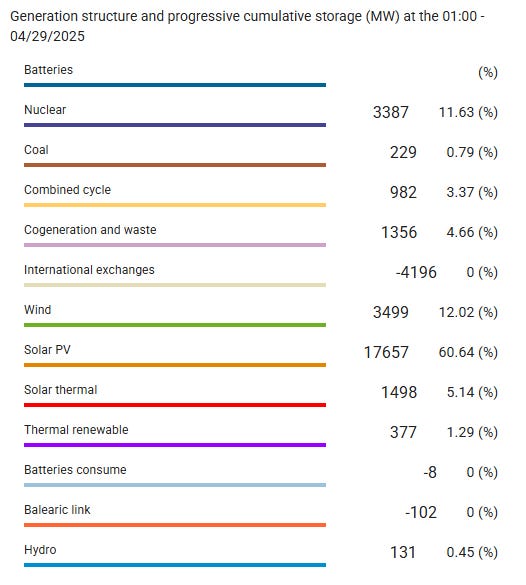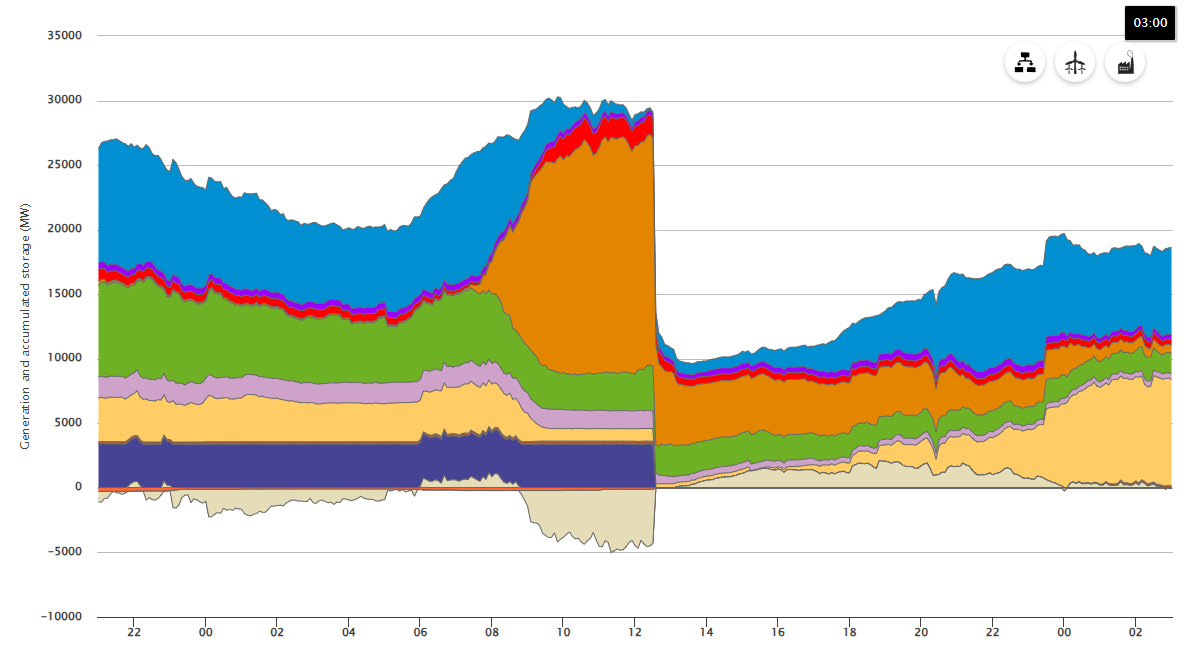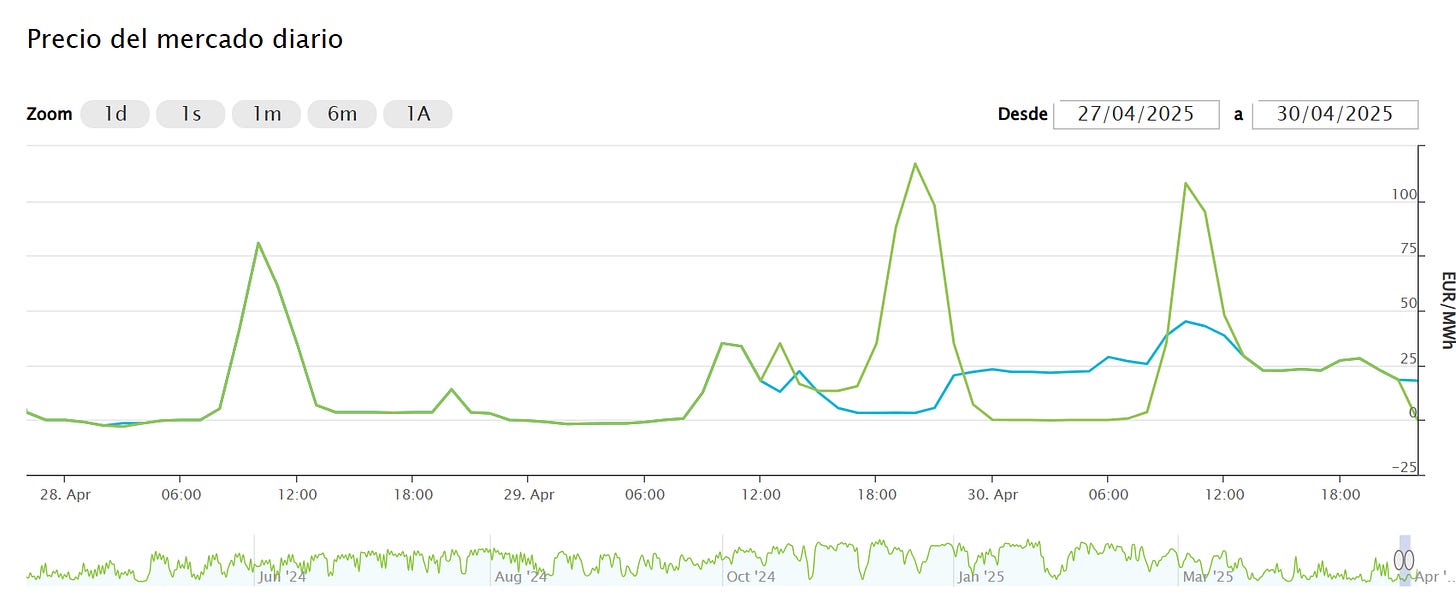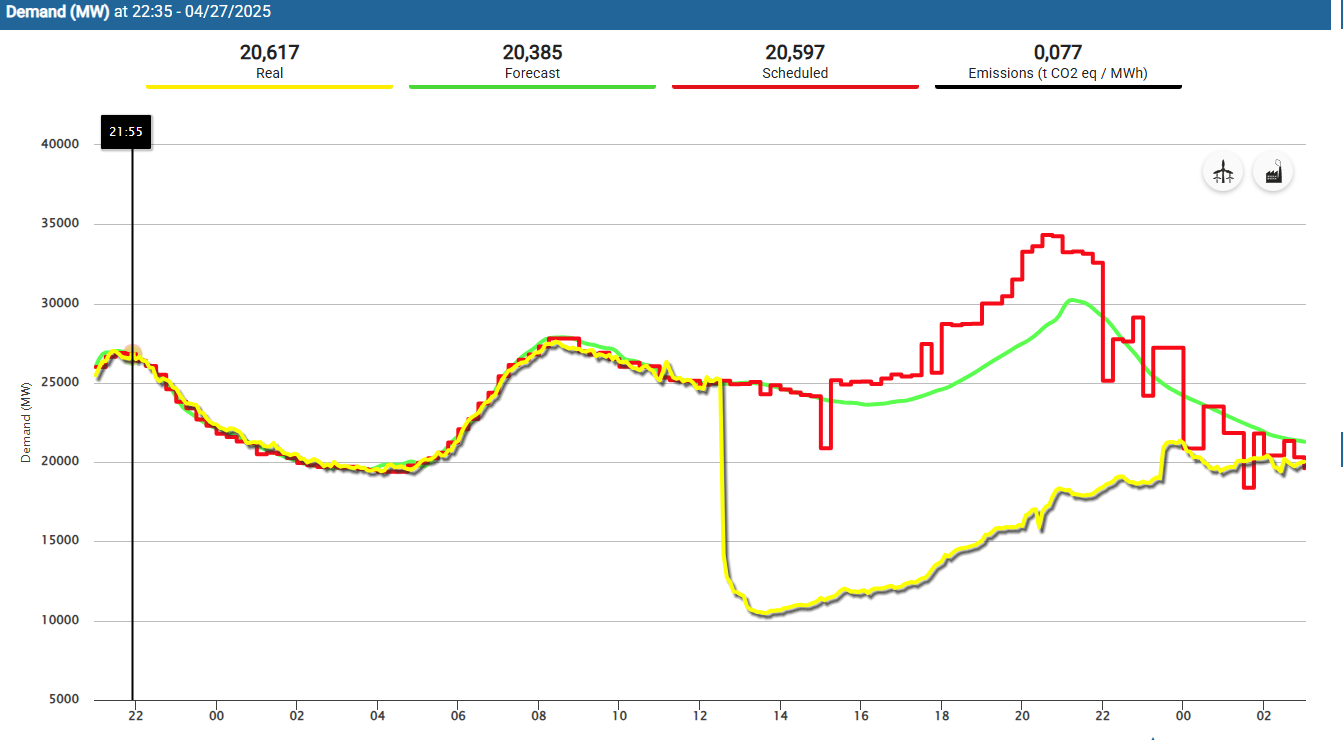Spain can now re-open them. We in New Jersey can’t. Murphy and Biden Democrats completely destroyed our clean, natural gas power plant at Beesleys Point!
Click Here For Link To Previous Post: Share These 15 Facts: We Need Power Plant Back At Beesleys Pt, Upper Township. – Liberty and Prosperity
Energy modelers Isaac Orr and Mitch Rolling write about the energy issues facing our world. Click to read Energy Bad Boys, a Substack publication with thousands of subscribers. Click Here For Link To Original Post Of May 3, 2025.
Everything you need to know about Spain’s power outage

A quick note: Hi everyone, we’re back to once a week just in time for the Spanish blackouts. We couldn’t have written this piece without the help of our friend Guillem Sanchis Ramírez, a Spanish nuclear engineer who works with the non-profit Econucleares, an organization working to save Spain’s nuclear plants. If you like this article and you have the means, please send them a little dinero.
On April 28th, 2025, 50 million people in Spain, were affected by a massive country-wide blackout. According to Bloomberg, about 15 gigawatts (GW) of power, about 60 percent of the country’s generation vanished from the grid in a matter of seconds right before the blackout at around 12:35 p.m.
The sudden outage caused massive cascading outage that disrupted businesses, hospitals, public transportation, and communication systems, leaving most of the nation without power for approximately 12 to 14 hours.
Reports indicate that the blackout was “very likely” due to a solar plant producing less than expected, and seconds later, there was a “massive” drop in other renewable-electricity production.
Just before the blackout hit, solar photovoltaic (PV) panels supplied 60 percent of demand, solar thermal supplied 5 percent, and wind supplied 12 percent—meaning 78 percent of the electricity load was met with weather-based, intermittent resources. Nuclear accounted for 11.63 percent, coal just 0.79 percent, combined cycle gas plants 3.37 percent, cogeneration and waste accounted for 4.66 percent, thermal renewable 1.29 percent, and hydro 0.45 percent.


As a result, Javier Blas, an opinion columnist at Bloomberg, called the outage the “first major blackout of the renewable-energy era.”
No Spin Zone
Normally, a drop in frequency can be mitigated by the spinning inertia of large, conventional generators, such as coal, natural gas, nuclear, and hydroelectric plants. However, wind and solar PV are inverter-based resources (IBRs), not to be confused with IBS, that do not provide any inertia to the grid.
To take a step back, grid inertia refers to the ability of an electrical power system to maintain stable frequency in response to sudden changes in supply or demand. Inertia is primarily provided by the kinetic energy stored in the rotating masses of synchronous generators like the conventional generators listed above.
Thermal plants create a very large, resilient boulder. Renewables, at best, create a pebble.
According to the National Renewable Energy Laboratory, this stored energy can be particularly valuable when a large power plant fails, as it can temporarily make up for the power lost from the failed generator. This temporary response—which is typically available for a few seconds—allows the mechanical systems that control most power plants time to detect and respond to the failure.
At the time of the blackout, 78 percent of Spain’s electricity was being served by wind and solar, which do not provide meaningful amounts of inertia to the grid, and the remaining 22 percent was unable to make up for the loss in frequency. More battery storage on the system would have helped because batteries are excellent frequency regulators, but Spain’s grid has just 25 megawatts (MW) of battery storage on it system.
Negative Prices: A Reliability No No
The problem in Spain isn’t that they don’t have enough reliable power plants.
Data from Red Electrica, the Spanish grid operator, shows the country has plenty of dispatchable capacity to meet its peak system loads, which are usually around 38,000 MW to 41,000 MW.

The issue is that, leading up to the blackouts, these reliable power plants were not being used because wholesale power prices in Spain were negative, and therefore could not provide critical system inertia.
Data from OMIE show that wholesale power prices were slightly negative from midnight on April 29th leading up to the blackout. These negative prices are well below the marginal operating costs of the conventional power plants, and as a result, the market essentially told them that their services were not needed.

We see similar situations in the United States, where the Production Tax Credit (PTC) encourages wind generators to produce electricity even at negative prices. The negative effects of these subsidies are most acute in the Electric Reliability Corporation of Texas (ERCOT) region, where low wholesale power prices can force existing thermal generators off the grid and chill investment in new gas plants needed for reliability.
As we detailed in our piece, The Levelized Cost of Blackouts, power outages impose massive societal costs on the families and businesses that experience them. Estimates for the economic losses associated with the Spanish blackout suggest the power outages cost Spaniards mucho dinero.
According to the Insurance Journal:
Spain’s main business lobby CEOE estimated the outage would shave 1.6 billion euros ($1.82 billion), or 0.1%, off gross domestic product, noting it could take oil refineries a week or more to resume their operations fully, and that some industrial ovens had been damaged.
The meat industry estimated losses of up to 190 million euros as fridges lost power, among other factors. The blackout lasted more than 12 hours in some areas of Spain.
Other estimates are even higher, as Reuters reports the investment bank RBC said the economic cost of the blackout could range between 2.25 billion euros ($2.56 billion) and 4.5 billion euros ($5.11 billion), equating to 0.11 percent to 0.3 percent of the country’s 2024 gross domestic product (GDP) of $1.72 trillion.
To figure out the cost of the blackouts in per MWh terms, we accessed data from Spain’s real-time data dashboard showing the supply and forecast demand. We subtracted the real-time generation from the load forecast to estimate the MWhs of unserved load from 12 pm on April 28th through 2 am on the 29th. Using this methodology, there were a total of 134,000 MWhs of unserved load during this time period.

To calculate the Value of Lost Load, which is the most common measure used to estimate the value of lost electric service, we divided the number of unserved MWhs of load by the loss estimates for the sources above. This gave us a range of $13,551.27 to $38,047.80 per MWh of unserved load.

As we noted previously, the data from this dashboard isn’t accurate because generation on the grid reached zero at one point. As a result, our per MWh costs are higher than they would be if we had access to the correct data. However, this exercise still shows that it is incredibly expensive to be without power, even for half a day.
Spanish Pipedream: Energy Policy in España
Needless to say, Spain wouldn’t have been in this situation if it weren’t pursuing policies that mandate the country shift most of its electricity generation to wind and solar.
In yet another example that God has a sense of humor, the blackouts occurred just weeks after Bloomberg reported that Spain remains committed to following Germany’s footsteps by shutting down their seven remaining nuclear plants and replacing them with wind, solar, and battery storage, with some natural gas remaining on the system.
Spain is ignoring calls to reconsider its nuclear decommissioning plans, betting renewables and battery storage will make up for the upcoming energy shortfall.
The country is plowing ahead with plans to shut down its seven nuclear reactors, which currently contribute 20 percent of its power mix, over the next decade. It’s also set to close its last coal plant this year.
The blackouts also happened just 12 days after Spain claimed it had powered its grid entirely by renewables for the first time on a weekday. According to PV Magazine:
At 11:15 a.m. that day on April 16, wind and PV combined to generate 100.63% of total demand – a first in Spain’s energy history. Unlike previous milestones, this occurred on a weekday.
Of course, outlets like Reuters have been quick to point out that the problem with Spain’s grid wasn’t that it was heavily dependent on renewables at the time of the blackouts, but rather that Spain needs to do a better job of managing the renewables.
There are elements of truth to this argument, but it also sounds an awful lot like “But we’ve never tried real Communism!” Just like Communism, the “mismanagement” of the green movement is pursuing it in the first place.
The problem for wind and solar advocates is their arguments that wind and solar are the cheapest forms of energy are reliant upon “creative” accounting schemes that omit the cost of additional transmission lines, backup power generators, overbuilding and curtailment costs, and the additional costs that would be incurred to build and operate equipment like grid forming inverters and synchronous condensers to bolster system inertia and maintain system frequency.
Conclusion
Spain has two main pathways to prevent future blackouts. If they want to do it the easy way, they can increase the utilization rates of their dispatchable nuclear and natural gas generators and govern the amount of wind and solar on their system at any one time, which will maintain adequate levels of inertia on the grid and provide more value for frequency control.
If they want to do it the harder and more expensive way, they can invest heavily in battery storage, grid-forming inverters, and synchronous condensers. They’ll probably pursue both avenues.
Looking to the U.S., Spain’s massive blackout should be a warning to policymakers that subsidizing the adoption of unreliable wind and solar generators is a recipe for similar results. Based on the fact that Winter Storm Uri didn’t do the trick, we wouldn’t hold our breath for that end result.
Lastly, the news on this blackout changes a lot from day-to-day. If we missed anything, please let us know in the comments!
Please Like, Share and Subscribe to this post to help us grow the Legion of Bad.
Many people had great articles on the blackouts. Here are a few we relied on to inform our analysis.
Blackout by
Why Europe’s Lights Went Out by
Did Over-Reliance On Solar & Lack Of Grid Inertia Cause Spain’s Blackout? by
LibertyAndProsperity.com is a tax-exempt, non-political education organization of roughly 200 citizens who mostly live near Atlantic City, New Jersey. We formed this group in 2003. We volunteer our time and money to maintain this website. We do our best to post accurate information. However, we admit we make mistakes from time to time. If you see any mistakes or inaccurate, misleading, outdated, or incomplete information in this or any of our posts, please let us know. We will do our best to correct the problem as soon as possible. Please email us at info@libertyandprosperity.com or telephone (609) 927-7333.
If you agree with this post, please share it now on Facebook or Twitter by clicking the “share” icons above and below each post. Please copy and paste a short paragraph as a “teaser” when you re-post.
Also, because Facebook, YouTube and other social media often falsely claim our posts violate their “community standards”, they greatly restrict, “throttle back” or “shadow ban” our posts. Please help us overcome that by sharing our posts wherever you can, as often as you can. Please copy and paste the URL link above or from the Twitter share button to the “comments” section of your favorite sites like Patch.com or PressofAtlanticCity.com. Please also email it to your friends. Open and use an alternate social media site like Gab.com.
Finally, please subscribe to our weekly email updates. Enter your email address, name, city and state in the spaces near the top of our home page at Homepage – Liberty and Prosperity. Then click the red “subscribe” button. Or email me at sethgrossman@libertyandprosperity.com or address below. Thanks.
Seth Grossman, Executive Director
LibertyAndProsperity.com
info@libertyandprosperity.com
(609) 927-7333

